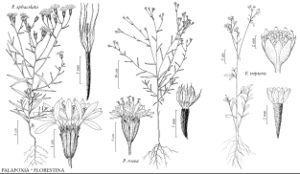Palafoxia
Gen. Sp. Pl., 26. 1816.
| Taxon | Illustrator ⠉ | |
|---|---|---|
 | Palafoxia sphacelata Palafoxia rosea Florestina tripteris | Linda Ann Vorobik Linda Ann Vorobik Barbara Alongi |
Annuals or perennials, 10–80 (–150+) cm. Stems erect, branched (mostly distally). Leaves cauline; opposite (proximal) or alternate (mostly); petiolate or sessile; blades (1-nerved or 3-nerved) broadly lanceolate to linear, margins entire, faces sparsely to moderately scabrellous to strigillose or appressed-puberulent (hairs 0.1–0.8+ mm), not glanddotted. Heads radiate, discoid, disciform, or radiant, in ± corymbiform arrays. Involucres narrowly cylindric or turbinate to hemispheric, 3–15+ mm diam. Phyllaries persistent or falling (in fruit), 8–14 in 2–3 series (erect in flowering, reflexed in fruit, purplish, or whitish, linear to oblanceolate, subequal or unequal, herbaceous to membranous). Ray-florets 0, or 3–13, pistillate, fertile; corollas white or pinkish to purplish. Disc-florets 12–40 (–90), bisexual, fertile; corollas pinkish to purplish or whitish (glabrous or sparsely hairy, sometimes stipitate-glandular), tubes shorter than cylindric throats or much longer than short, broadly funnelform throats, lobes 5, lance-linear or linear (equal or unequal). Receptacles flat, pitted or knobby, epaleate. Cypselae obpyramidal, 4-angled, densely to sparsely hairy (hairs straight); pappi usually persistent, of 4–10 rotund and callous-thickened, or spatulate to subulate, medially thickened, laterally scarious scales in 1–2 series (all, some, or none aristate, all alike or pappi of outer cypselae shorter, rarely 0). x = 12.
Distribution
s United States, Mexico
Discussion
Species 12 (10 in the flora).
Circumscriptions of species adopted here closely follow those of B. L. Turner and M. I. Morris (1976). Some of their circumscriptions, especially those of Palafoxia callosa, P. rosea, and P. texana, merit reconsideration and possibly different interpretations. Their infraspecific taxa are not formally recognized here.
Selected References
Lower Taxa
Key
| 1 | Ray florets 3–13 | > 2 |
| 1 | Ray florets 0 (peripheral florets sometimes with enlarged, ± zygomorphic corollas) | > 4 |
| 2 | Leaf blades narrowly lanceolate to linear, 2–6 mm wide; phyllaries 6–8 mm; cypselae 5–6 mm | Palafoxia reverchonii |
| 2 | Leaf blades broadly to narrowly lanceolate, 3–25 mm wide; phyllaries 7–16+ mm; cypselae 6–9 mm | > 3 |
| 3 | Stems usually stipitate-glandular ± throughout; phyllaries mostly 3–5 mm wide; ray corollas 10–20 mm, laminae 9–14 mm | Palafoxia hookeriana |
| 3 | Stems stipitate-glandular only distally (mainly on peduncles), if at all; phyllaries mostly 1.5–3 mm wide; ray corollas 15–25 mm, laminae 5–8(–12) mm | Palafoxia sphacelata |
| 4 | Corolla throats ± cylindric, longer than lobes | > 5 |
| 4 | Corolla throats ± funnelform, shorter than lobes | > 6 |
| 5 | Perennials, subshrubs, or shrubs; leaf blades narrowly elliptic to ovate; phyllaries 5–9 mm; cypselae 6–8 mm | Palafoxia feayi |
| 5 | Annuals (rarely persisting); leaf blades narrowly lanceolate to linear; phyllaries 10–25 mm; cypselae 10–16 mm | Palafoxia arida |
| 6 | Perennials (rhizomatous); phyllaries unequal (outer shorter) | Palafoxia integrifolia |
| 6 | Annuals (rarely persisting, becoming ± shrubby, not rhizomatous); phyllaries ± equal | > 7 |
| 7 | Involucres ± cylindric; phyllaries 10–15 mm; corollas of outer florets ± zygomorphic | Palafoxia riograndensis |
| 7 | Involucres ± turbinate to campanulate; phyllaries 3–10 mm; corollas of all florets ± actinomorphic | > 8 |
| 8 | Phyllaries 3–5 mm; corollas 5–6 mm; pappus scales mostly 0.3–1 mm | Palafoxia callosa |
| 8 | Phyllaries 5–10 mm; corollas 7–10 mm; pappus scales (1.5–)3–8 mm | > 9 |
| 9 | Leaf blades narrowly lanceolate to linear, 2–6(–12) mm wide; phyllar-ies usually stipitate-glandular | Palafoxia rosea |
| 9 | Leaf blades mostly lanceolate, (5–)10–20 mm wide; phyllaries rarely stipitate-glandular | Palafoxia texana |